Adenomyosis or internal endometriosis is a gynecological disease, most often diagnosed in women after 35–40 years of age. It is characterized by the growth of the uterine mucosa into its muscle layer. At the same time, the work of the female organs is disrupted, the immunity is reduced, the patient may experience severe, prolonged pain. The fact that this is uterine adenomyosis became known not so long ago, the disease has not yet been fully studied, and effective ways to completely get rid of pathology and prevent development have not been found.
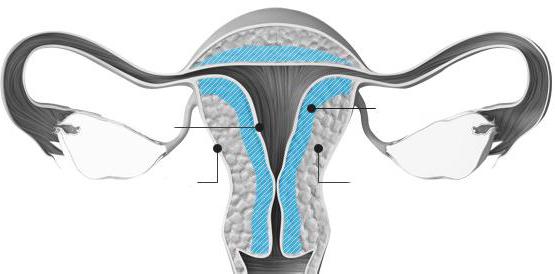
Definition
The mucous membrane of the uterus or the endometrium covers the uterine cavity and tends to increase in volume during menstruation, and later envelops the fertilized egg. During normal functioning of the organ, the membrane remains in the uterine cavity, but in case of damage, weakened immunity or other provoking factors, the mucous membrane begins to penetrate into the inner layers of the uterus.
In more complex cases, the endometrium can even penetrate into neighboring organs and this is very similar to a malignant tumor. This problem is often detected during infertility testing. The exact reasons why there are failures in the growth of the endometrium are not fully known.
Types of Adenomyosis
According to statistics, adenomyosis most often occurs in women after 40 years, when the body is undergoing serious hormonal changes associated with the onset of menopause. Internal endometriosis is divided into three types:
- nodular - in this form, the tissues of the uterine mucosa enter the muscle layer and contribute to the formation of nodes of different sizes, which are filled with blood or brown liquid during the menstrual cycle;
- diffuse adenomyosis - characterized by the formation in the tissues of blind pockets penetrating into adjacent tissues and even organs, the formation of fistulas in the pelvic cavity is often observed here;
- mixed - this form is distinguished by the combination of all the above features.
Today, medical communities are trying to inform a greater number of people about what adenomyosis is in women. A photo and description of the signs of the disease can be found in the corridors of women's wards and clinics.
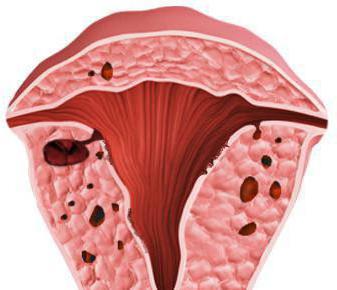
The risks of developing the disease
There is a classification of levels of immersion of endometrial cells in uterine tissue, that is, the stage of development of the disease. It is applicable only with a diffuse form of the disease:
- I degree - here the cells begin to grow so far only in one area of the uterus;
- II degree - endometrial cells penetrate deeper into the uterus, spread to almost half of the muscle tissue;
- III degree - there is an immersion of cells in the muscles of the uterus more than half;
- IV degree - the most dangerous, cells grow outside the uterus and can affect other organs of the small pelvis.
Launched cases can lead to serious deviations in the work of not only female functions, but also of the whole organism, up to the development of oncology.
How does the disease develop?
Not many patients know what adenomyosis in women is and its causes. Meanwhile, the problem is very serious and covers more than 40% of women after 40 years. The resulting tumor is considered to be benign, since with the "relocation" of the tissues of the mucous membrane into other organs, up to the bladder, no genetic changes occur in the cells. In the late stages of the development of the disease, endometriosis tissue actively spreads throughout the body and gradually depletes it. The process can take several years or even decades. In rare cases, adenomyosis can qualify as a malignant neoplasm.
Medication is not always effective, and even with a positive trend, the disease can continue to progress after "subsiding". In the later stages, surgery is recommended. In advanced cases or with provoking factors, adenomyosis can lead to severe bleeding, and, therefore, threaten human life and health.
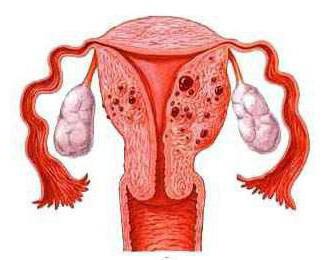
Causes of the disease
To date, doctors around the world have not come to a consensus on the etiology of the development of the disease. The only proven version is that the disease is associated with hormones, possible age-related or artificial malfunctions in the body.
Known versions of the development of adenomyosis in women:
- mechanical damage to the membrane during surgery: cesarean section, abortion or curettage;
- disruptions in the growth and reproduction of endometrial cells occur even in the period of uterine development, subsequently, hormonal failure becomes the trigger for the development of the disease;
- genetic predisposition to the development of benign and malignant tumors;
- too early or, conversely, late onset of menstruation;
- use for the protection of uterine spirals;
- some doctors associate the development of pathology with the malfunctioning of the endocrine system, this deviation is manifested in a strong violation of the menstrual cycle;
- general weakening of the immune system contributes to the development of hidden pathologies that the body could manage on its own before, an indicator of the weakening of the body will be frequent and prolonged infectious diseases;
- severe physical activity is destructive to the same extent as its complete absence;
- the same reason may be a weak opening of the cervix during the passage of the egg, in which case the endometrial cells receive double pressure and are displaced.
From the foregoing, it is clear that the exact cause will be determined in each case, based on the signs of uterine adenomyosis. Sometimes, doctors call strong stress, a sedentary lifestyle, and even a late sex life as the main reasons.
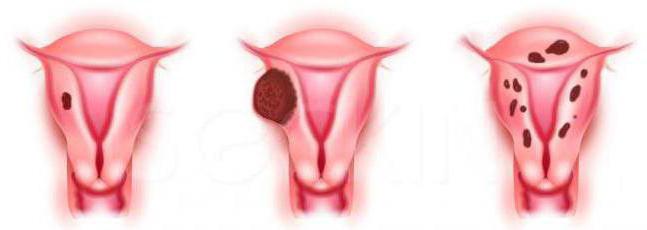
Symptoms
The problem is that it is very difficult to identify the disease in time and take urgent treatment measures. Symptoms of adenomyosis in women strongly resemble deviations during menstruation:
- long periods, from 7 to 15 days;
- copious discharge, large clots;
- even after the cycle ends, spotting appears;
- sometimes, on the contrary, the menstrual cycle is halved;
- pain during intercourse;
- with adenomyosis, pain occurs before and after the menstrual cycle;
- anemia may develop: pallor, weakness, decreased activity and peeling of the skin of hands, face.
Concomitant symptoms are weakness, drowsiness, a general decrease in immunity. At later stages of the disease, shortness of breath, dizziness, loss of activity, and in some cases even disability, appear. The main symptom is abundant discharge before and after menstruation. All these signs individually do not speak specifically about problems with the uterus, but in aggregate there is already reason to think and consult a gynecologist to confirm the symptoms of uterine adenomyosis and treatment.
Diagnostics
One of the main signs of the development of the disease is severe pain in the pelvic area several days before and after menstruation. Often, determining the location of pain helps with the diagnosis. When the isthmus of the uterus is affected, pain is given to the rectum and vagina, and when endometriosis cells spread to the corner of the cervix uteri - to the inguinal region.
Accurate diagnosis of adenomyosis is possible only after examination by a gynecologist:
- at the first examination, the doctor collects an accurate history based on the patient's complaints; important information about the onset of pain: during emptying, during sexual intercourse or in other circumstances;
- the disease is detected by ultrasound; during the study, the doctor draws attention to a possible increase in the uterus, the presence of the mucous membrane and reveals the fact of possible germination in the organ tissue;
- Some doctors prescribe hysteroscopy for patients to confirm the diagnosis and exclude other diseases, since similar symptoms can occur with uterine fibroids, a malignant tumor or polyps on the uterus.
But the most effective method for determining adenomyosis is the use of a transvaginal regulator. This collection is called biopsy. The device is inserted into the uterine cavity under anesthesia and reveals the state of the walls of the organ. Already on the basis of all these data, the doctor makes a diagnosis.
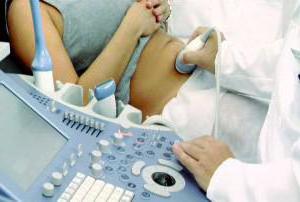
Diagnosis Problems
Since adenomyosis is a poorly understood disease, many doctors miss it, attributing the symptoms to other gynecological abnormalities. Prolonged bleeding is also a sign of uterine fibroids, malignant tumors or hormonal age-related disorders. Therefore, experienced doctors try to exclude all other possible options in order to accurately verify the diagnosis of adenomyosis.
Treatment features
Today, there are several sources of information about adenomyosis in women, treatment and possible complications of the disease. You can find information on the Internet, at medical forums, and also ask your attending gynecologist.
Therapy depends on the degree of the course of the disease, on how much the endometrial cells have managed to deepen into the uterine tissue. There are two known methods: medical and surgical. Both methods will be considered in more detail below, including based on feedback on the treatment of adenomyosis.
Hormone treatment
Conservative therapy consists in the appointment of hormonal drugs, and if necessary, anti-inflammatory drugs and vitamins to increase immunity. In some patients, there is a manifestation of neurosis due to severe pain or problems when trying to get pregnant. In this case, the woman is sent for a consultation with a psychiatrist, since the right attitude is the main guarantee of effective treatment.
According to some reviews, treatment of adenomyosis with a weak expression can be omitted altogether. If the doctor, or rather a few, came to the conclusion that nothing threatens the woman’s life and health, only general strengthening vitamins are prescribed to the patient. But, the course of the disease must be monitored.
Surgery
There are other reviews of adenomyosis, as a serious illness, with untimely treatment capable of moving to a complex stage of development bordering on a malignant tumor. Therefore, they consider the surgical treatment method the most productive, and in some cases the only one.
Usually, the indication for surgical intervention is the lack of effect with drug therapy, the appearance of suppuration, adhesions and the development of hyperplasia. Before the operation, all possible tests are carried out to identify contraindications for surgery. The operation is not complicated, it is considered ordinary, and the recovery period takes no more than a week. After removal of neoplasms, a woman is recommended to establish a hormonal spiral. Firstly, it is an excellent contraceptive, and secondly, the spiral has a good effect on uterine cells.
If a woman after 40 years has progression of adenomyosis, the surgeon may prescribe removal of the uterus. Since the III degree of development, in addition, complicated by nodal neoplasms and myoma, can lead to the development of a malignant tumor.

Pregnant treatment
All women planning a pregnancy are advised to undergo an examination to identify diseases of endometriosis, since this factor can significantly affect conception and further development of the fetus. If during the study a woman develops adenomyosis, the patient is prescribed a course of hormonal drugs. After the course, you must wait at least six months before making conception.
When determining the disease in the second or third trimester, a decision on treatment is made after studying the condition of the cells of the uterine mucosa. The fact is that at this time the mother’s body releases a lot of hormones that normalize the functioning of cells, and special treatment may not be necessary.
Treatment with folk remedies
Tinctures, decoctions and lotions from herbs are unlikely to cure myoma, swelling or help in stabilizing hormones. You should not choose folk remedies as a panacea for all diseases, and, in particular, replace medical treatment or surgery with “grandmother's secrets of longevity”. But, as an auxiliary measure for the treatment of adenomyosis, folk remedies can help improve the patient's condition.
To relieve inflammation and improve immunity, a decoction from the grass of the cinquefoil and the pine forest is suitable. One tablespoon is placed in a 10 liter pot and poured with water. Boil for 25-30 minutes, allow the broth to cool and take one spoon a day after meals.
In addition, it is recommended to take soothing decoctions of herbs, for example, infusion on the bark of white willow. It has anti-inflammatory and antispasmodic effects. The Asian plant angelica has always been used to treat various female ailments. It contains substances that contribute to the expansion of blood vessels and stimulation of the central nervous system. Observation of patients suggests angelica's ability to influence the tissues of female organs, allowing the muscles of the uterus to relax.
The use of folk remedies or additional vitamins must be discussed with your doctor and beware of prescribing treatment yourself.

Complications
Reviews of adenomyosis confirm the danger of this disease. Endometrial cells tend to spread not only to the genitals, but also to the digestive and urinary systems. In this case, systemic malfunctions in the work of the affected organs occur. As a result, intestinal obstruction develops, blood can enter the pleural cavity and provoke pneumonia. In addition, the disease has not been fully studied, and so far many doctors have expressed concern about the possible transition of adenomyosis to cancer.
Prevention
The best way to prevent the serious consequences of any gynecological disease is to see a doctor regularly. In addition, frequent and intense sunbathing should be avoided; solar radiation also causes hormonal malfunction and can cause changes in cell division.
As a prophylaxis, gynecologists recommend the installation of hormonal intrauterine devices. This device affects the focus of the disease and normalizes the hormonal background. The spiral is set for 5 years and helps to reduce the duration and profusion of menstruation.
Do not forget that any disease can again make itself felt. Therefore, if medication was prescribed or surgery was performed, hormonal contraceptives should be taken or a spiral should be established. Otherwise, relapse can be much stronger and more destructive than the previous stage.

Possible consequences
The mechanism of development and the impact of the disease on the body is not fully understood. Many doctors believe that the main consequence of adenomyosis is infertility. However, another group of specialists believes that as an independent disease, internal endometriosis cannot lead to such serious consequences. The last statement is true only for the initial stages, when the cells of the uterine mucosa have not yet penetrated deep into the organ and have not caused serious damage to the female body.
At the III and IV stages, adhesions, nodes with blood and other pathological changes develop. The lack of treatment leads to persistent remission, and in complex cases to serious inflammation and even cancer. Gynecologists consider adenomyosis the first sign of a malfunction of the female body.